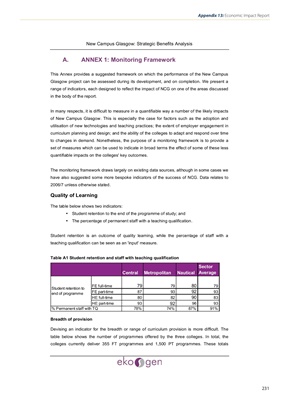
New Campus Glasgow: Strategic Benefits Analysis
A. ANNEX 1: Monitoring Framework
This Annex provides a suggested framework on which the performance of the New Campus
Glasgow project can be assessed during its development, and on completion. We present a
range of indicators, each designed to reflect the impact of NCG on one of the areas discussed
in the body of the report.
In many respects, it is difficult to measure in a quantifiable way a number of the likely impacts
of New Campus Glasgow. This is especially the case for factors such as the adoption and
utilisation of new technologies and teaching practices; the extent of employer engagement in
curriculum planning and design; and the ability of the colleges to adapt and respond over time
to changes in demand. Nonetheless, the purpose of a monitoring framework is to provide a
set of measures which can be used to indicate in broad terms the effect of some of these less
quantifiable impacts on the colleges' key outcomes.
The monitoring framework draws largely on existing data sources, although in some cases we
have also suggested some more bespoke indicators of the success of NCG. Data relates to
2006/7 unless otherwise stated.
Quality of Learning
The table below shows two indicators:
• Student retention to the end of the programme of study; and
• The percentage of permanent staff with a teaching qualification.
Student retention is an outcome of quality learning, while the percentage of staff with a
teaching qualification can be seen as an 'input' measure.
Table A1 Student retention and staff with teaching qualification
Central Metropolitan Nautical Sector
Average
FE full-time 79 79 80 79
FE part-time 87 93 92 93
HE full-time 80 82 90 83
HE part-time 93 92 96 93
78% 74% 87% 91%
% Permanent staff with TQ
Student retention to
end of programme
Breadth of provision
Devising an indicator for the breadth or range of curriculum provision is more difficult. The
table below shows the number of programmes offered by the three colleges. In total, the
colleges currently deliver 355 FT programmes and 1,500 PT programmes. These totals
231
Appendix 13: Economic Impact Report